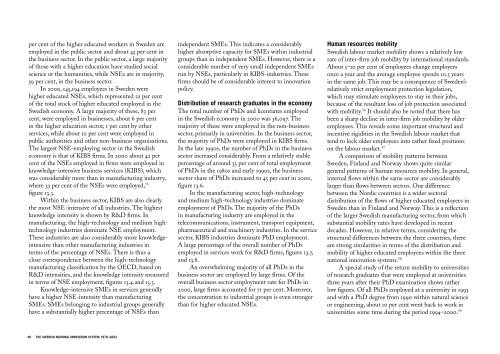The Swedish National Innovation System 1970-2003 - Vinnova
The Swedish National Innovation System 1970-2003 - Vinnova
The Swedish National Innovation System 1970-2003 - Vinnova
Create successful ePaper yourself
Turn your PDF publications into a flip-book with our unique Google optimized e-Paper software.
per cent of the higher educated workers in Sweden are<br />
employed in the public sector and about 45 per cent in<br />
the business sector. In the public sector, a large majority<br />
of those with a higher education have studied social<br />
science or the humanities, while NSEs are in majority,<br />
59 per cent, in the business sector.<br />
In 2000, 145,194 employees in Sweden were<br />
higher educated NSEs, which represented 22 per cent<br />
of the total stock of higher educated employed in the<br />
<strong>Swedish</strong> economy. A large majority of these, 83 per<br />
cent, were employed in businesses, about 6 per cent<br />
in the higher education sector, 1 per cent by other<br />
services, while about 10 per cent were employed in<br />
public authorities and other non-business organisations.<br />
<strong>The</strong> largest NSE-employing sector in the <strong>Swedish</strong><br />
economy is that of KIBS firms. In 2000 about 42 per<br />
cent of the NSEs employed in firms were employed in<br />
knowledge-intensive business services (KIBS), which<br />
was considerably more than in manufacturing industry,<br />
where 33 per cent of the NSEs were employed, 55<br />
figure 13.3.<br />
Within the business sector, KIBS are also clearly<br />
the most NSE-intensive of all industries. <strong>The</strong> highest<br />
knowledge intensity is shown by R&D firms. In<br />
manufacturing, the high-technology and medium hightechnology<br />
industries dominate NSE employment.<br />
<strong>The</strong>se industries are also considerably more knowledgeintensive<br />
than other manufacturing industries in<br />
terms of the percentage of NSEs. <strong>The</strong>re is thus a<br />
close correspondence between the high-technology<br />
manufacturing classification by the OECD, based on<br />
R&D intensities, and the knowledge intensity measured<br />
in terms of NSE employment, figures 13.4.and 13.5.<br />
Knowledge-intensive SMEs in services generally<br />
have a higher NSE-intensity than manufacturing<br />
SMEs. SMEs belonging to industrial groups generally<br />
have a substantially higher percentage of NSEs than<br />
independent SMEs. This indicates a considerably<br />
higher absorptive capacity for SMEs within industrial<br />
groups than in independent SMEs. However, there is a<br />
considerable number of very small independent SMEs<br />
run by NSEs, particularly in KIBS-industries. <strong>The</strong>se<br />
firms should be of considerable interest to innovation<br />
policy.<br />
Distribution of research graduates in the economy<br />
<strong>The</strong> total number of PhDs and licentiates employed<br />
in the <strong>Swedish</strong> economy in 2000 was 36,097. <strong>The</strong><br />
majority of these were employed in the non-business<br />
sector, primarily in universities. In the business sector,<br />
the majority of PhDs were employed in KIBS firms.<br />
In the late 1990s, the number of PhDs in the business<br />
sector increased considerably. From a relatively stable<br />
percentage of around 35 per cent of total employment<br />
of PhDs in the 1980s and early 1990s, the business<br />
sector share of PhDs increased to 45 per cent in 2000,<br />
figure 13.6.<br />
In the manufacturing sector, high-technology<br />
and medium high-technology industries dominate<br />
employment of PhDs. <strong>The</strong> majority of the PhDs<br />
in manufacturing industry are employed in the<br />
telecommunications, instrument, transport equipment,<br />
pharmaceutical and machinery industries. In the service<br />
sector, KIBS industries dominate PhD employment.<br />
A large percentage of the overall number of PhDs<br />
employed in services work for R&D firms, figures 13.7,<br />
and 13.8.<br />
An overwhelming majority of all PhDs in the<br />
business sector are employed by large firms. Of the<br />
overall business sector employment rate for PhDs in<br />
2000, large firms accounted for 71 per cent. Moreover,<br />
the concentration to industrial groups is even stronger<br />
than for higher educated NSEs.<br />
Human resources mobility<br />
<strong>Swedish</strong> labour market mobility shows a relatively low<br />
rate of inter-firm job mobility by international standards.<br />
About 5–10 per cent of employees change employers<br />
once a year and the average employee spends 10.5 years<br />
in the same job. This may be a consequence of Sweden’s<br />
relatively strict employment protection legislation,<br />
which may stimulate employees to stay in their jobs,<br />
because of the resultant loss of job protection associated<br />
with mobility. 56 It should also be noted that there has<br />
been a sharp decline in inter-firm job mobility by older<br />
employees. This reveals some important structural and<br />
incentive rigidities in the <strong>Swedish</strong> labour market that<br />
tend to lock older employees into rather fixed positions<br />
on the labour market. 57<br />
A comparison of mobility patterns between<br />
Sweden, Finland and Norway shows quite similar<br />
general patterns of human resources mobility. In general,<br />
internal flows within the same sector are considerably<br />
larger than flows between sectors. One difference<br />
between the Nordic countries is a wider sectoral<br />
distribution of the flows of higher educated employees in<br />
Sweden than in Finland and Norway. This is a reflection<br />
of the larger <strong>Swedish</strong> manufacturing sector, from which<br />
substantial mobility rates have developed in recent<br />
decades. However, in relative terms, considering the<br />
structural differences between the three countries, there<br />
are strong similarities in terms of the distribution and<br />
mobility of higher educated employees within the three<br />
national innovation systems. 58<br />
A special study of the return mobility to universities<br />
of research graduates that were employed at universities<br />
three years after their PhD examination shows rather<br />
low figures. Of all PhDs employed at a university in 1993<br />
and with a PhD degree from 1990 within natural science<br />
or engineering, about 10 per cent went back to work in<br />
universities some time during the period 1994–2000. 59<br />
46 THE SWEDISH NATIONAL INNOVATION SYSTEM <strong>1970</strong>–<strong>2003</strong>

















